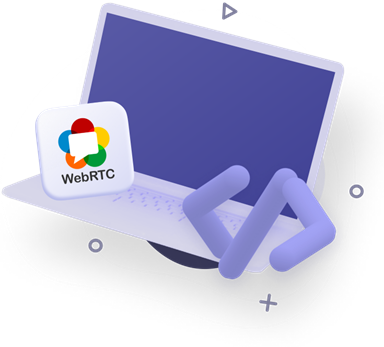
In the swiftly advancing arena of digital communication, WebRTC development solutions are becoming pivotal. WebRTC (web real-time communication) is an open-source initiative designed to enable smooth, real-time interactions over the internet. By removing the need for additional apps or plug-ins, WebRTC streamlines the exchange of data between users, making it indispensable for developers and enterprises.
A leading innovator in WebRTC is Geniusee. With their proficiency in creating bespoke software solutions, Geniusee is at the cutting edge, utilising WebRTC to develop more effective and dependable communication tools. By embedding WebRTC into diverse applications, they assist businesses in improving customer interactions and operational efficiency.
The journey and influence of WebRTC
WebRTC was initially created to overcome the limitations of the existing web infrastructure for real-time communications. Before its creation, there was no uniform method for direct data transfers between users on different browsers. Google identified this gap and led the development of WebRTC. They were soon joined by other tech behemoths like Mozilla, Microsoft, Opera, and Apple. The aim was to establish a unified platform supporting real-time communications without needing additional software.
Today, WebRTC's applications are extensive and diverse. From video calling and VoIP to IoT and telehealth, WebRTC is altering how we connect and communicate. Traditional video calling platforms like FaceTime and Skype, despite their popularity, fall short of WebRTC's universal compatibility and ease of use. WebRTC enables users to engage in high-quality video, audio, and data sharing directly through their browsers.

Photo credits: https://geniusee.com/webrtc-development
The technical backbone of WebRTC
WebRTC's capabilities are anchored in several critical APIs and codecs. The getUserMedia API seeks access to a device's camera, microphone, and screen, facilitating the capture of audio and video. The RTCPeerConnection API manages audio and video streaming between users, while the RTCDataChannel API oversees data streaming. These elements collaborate to enable real-time communication without additional software.
The choice of codecs is vital for WebRTC's performance. The most widely used codecs are H.264 and VP8. H.264 is prevalent but royalty-based, whereas VP8 is open-source and favoured for its accessibility. To guarantee seamless communication across platforms, The World Wide Web Consortium (W3C) and the Internet Engineering Task Force (IETF) mandate that all browsers support both codecs.
Benefits of WebRTC solutions
For companies aiming to incorporate real-time communication within their web and mobile applications, WebRTC technology presents numerous advantages, making it a highly favourable choice.
Efficient protocols and codecs
WebRTC employs efficient protocols and codecs to transmit audio, video, and data, optimising both bandwidth usage and overall performance. The technology can manage a high volume of peer-to-peer connections, scaling effortlessly to support large audiences. This efficiency ensures smooth, high-quality communications across diverse network conditions.
Easy integration
One of WebRTC's standout features is its ease of integration with existing web applications and frameworks. Its JavaScript APIs can be seamlessly embedded into web pages, allowing developers to quickly add real-time communication features. The straightforward API design minimises development time and accelerates the deployment of communication tools.
Security and privacy
WebRTC is designed with security and privacy at its core. It supports robust encryption, authentication, and authorisation mechanisms to safeguard communications and data. Users gain control over their privacy, with the capability to allow or deny access to their camera, microphone, and location, ensuring they share only what they are comfortable with. These features make WebRTC a secure option for real-time communication needs.
WebRTC across various sectors
WebRTC's adaptability is evident in its applications across multiple industries. In business communications, WebRTC enables effortless video conferencing and collaboration without cumbersome software installations. Companies like OnSIP are using WebRTC to develop VoIP solutions that streamline communications and boost productivity.
In the healthcare industry, WebRTC is transforming telehealth by providing secure, high-quality video consultations. Platforms like Teladoc utilise WebRTC to improve healthcare accessibility, allowing patients to connect with specialists regardless of location. This technology also paves the way for advancements in remote surgery and virtual reality applications in medicine.
The ecommerce sector is another beneficiary of WebRTC. By integrating video communication directly into websites, businesses can offer personalised customer support and virtual shopping experiences. This boosts customer satisfaction and increases sales by fostering a more interactive shopping experience.
The future trajectory of WebRTC
Looking to the future, the potential for WebRTC continues to grow. The rise of the Internet of Things (IoT) and the advent of 5G networks promise to further augment WebRTC's capabilities. The IoT is projected to expand to more than 500 billion connected devices by 2030, and WebRTC will play a crucial role in enabling seamless communication among these devices.
In the domain of smart home technology, WebRTC can facilitate real-time monitoring and control of connected devices. From video doorbells streaming live footage to your phone to smart security systems, the prospects are limitless. Furthermore, WebRTC's low latency and high reliability make it perfect for critical applications like emergency response systems and remote diagnostics.
Conclusion
WebRTC development solutions are redefining the future of digital communication. Offering a standardised, open-source platform for real-time communication, WebRTC enables developers to create efficient, secure, and scalable applications. Companies like Geniusee are leading this transformation, enhancing sectors from healthcare to ecommerce.
In healthcare, WebRTC has revolutionised telehealth services, providing seamless video consultations and improving patient experience. In ecommerce, it facilitates real-time customer support and interactive shopping experiences, allowing businesses to connect more personally with customers.
As technology evolves, WebRTC's significance in daily life will grow. Whether improving telehealth, business communications, or IoT innovations, WebRTC is becoming a cornerstone of modern digital interaction. Its applications also extend to education and entertainment, enabling remote learning and enhancing live streaming and interactive media experiences.
With its broad applications and continuous advancements, WebRTC is set to play a pivotal role in the digital future, transforming how we interact and communicate in an increasingly connected world.
Copyright 2024. Featured post made possible by Geniusee.
